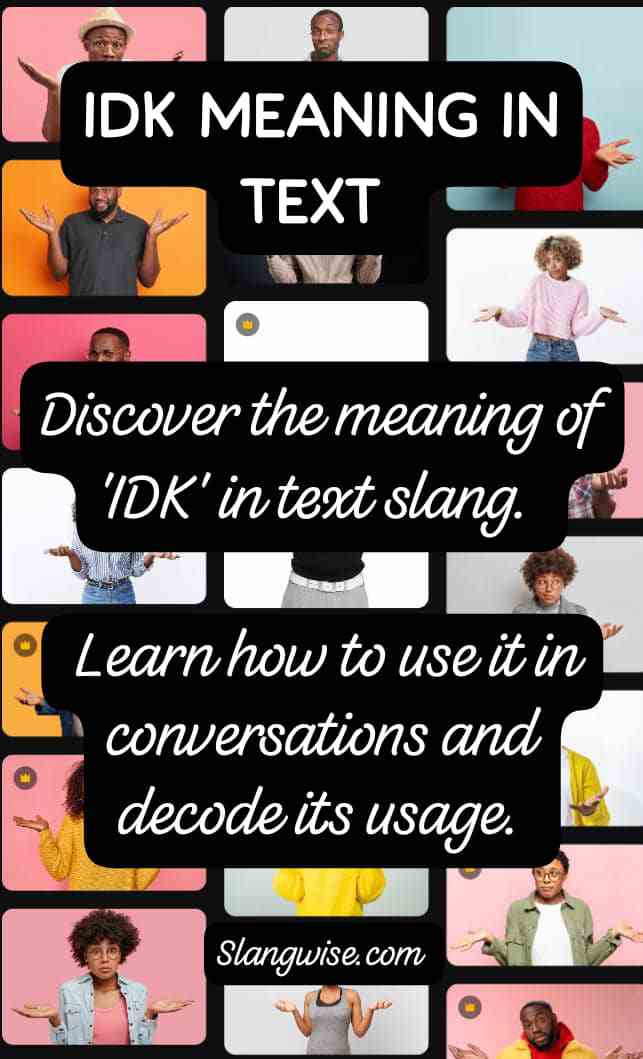Table of Contents
IDK Meaning
IDK stands for “I don’t know.” This compact three-letter acronym is one of the most common replies across texting, DMs, comment threads, and chat platforms. Despite brevity, IDK conveys tone, intent, and conversational stance, making context the deciding factor in interpretation.
Key takeaways
- IDK meaning in text: “I don’t know.”
- Common uses: honest uncertainty, polite deflection, conversational filler, or terse disengagement.
- Tone cues: punctuation, capitalization, and emojis alter perceived intent.
- Appropriate contexts: informal chats and quick replies; avoid in formal or professional messages.
How IDK functions in conversation
IDK serves several conversational roles beyond a literal admission of ignorance. Formatting choices shape tone: IDK. reads firmer than idk, while Idk… implies uncertainty or trailing thought. Adding an emoji, such as 🙃 or 🤷softens or clarifies intent.
Functions includes but not limited to:
- Straight answer: A direct response when factual information is missing.
Example: “Meeting time?” — IDK. - Deflection: A gentle way to avoid commitment or debate.
Example: “Will this plan work?” — “IDK, maybe.” - Hedging before opinion: A preface to a tentative viewpoint.
Example: “IDK, that movie felt off.” - Disengaged reply: Short, context-free IDK can signal annoyance or distance.
Example: “Where’s the file?” — IDK. (abrupt tone)
Think You’re a Texting Guru? 📲 Put your skills to the test! Master 250 popular acronyms and take our impossible slang quiz. You’ll be SHOOK by what you don’t know
IDK Meaning: Origins and Adoption
The catchphrase “I don’t know” is a basic element of spoken language. The acronym IDK became widespread with early instant messaging and SMS culture, where speed and character limits encouraged initialisms like BRB, LOL, and IDK.
Adoption across social platforms has made IDK a durable part of digital vocabulary rather than a passing fad.
When to avoid IDK
IDK works well in casual environments but should be replaced with clearer language in professional or formal contexts. Examples of better alternatives:
- Replace IDK in work emails with: “Status unknown; will confirm by [time].”
- Replace IDK in client-facing messages with: “That information is not available right now; an update will follow.”
Related Posts
- ISTG Meaning and How to Use It in Text, Snapchat, TikTok and Instagram
- NSFW at Work: What HR Won’t Tell You About Sharing NSFW Contents Online
- Shopping Slang: 60 Must-Know Terms Every Smart Deal-Hunter Uses
Useful responses when someone types IDK
When a contact replies with IDK, helpful next moves include:
- Ask a targeted follow-up to narrow the unknown.
- Offer to check and report back if responsibility for the answer exists.
- Provide context or options if decision-making is stalled.
IDK examples that illustrate nuance
- Group chat: “Where to eat?” — “IDK, any suggestions?” (invites input)
- Project thread: “Is the report done?” — “IDK, checking now.” (signals follow-up)
- Comment thread: “Best album of the year?” — “idk, too many good ones” (casual hedging)
- Argument: “Why did they leave?” — IDK. (may indicate emotional distance)
Final note
IDK performs as a concise conversational tool. Effective use relies on awareness of tone and context; when clarity matters, pairing IDK with a follow-up action or a clearer alternative improves communication and keeps conversations moving.
FAQs
Not inherently. Tone and context determine whether IDK reads neutral, dismissive, or curt.
Letters are typically read individually: eye-dee-kay. In speech, the full phrase “I don’t know” is often used instead.
Yes. IDK remains a widely recognized abbreviation across generations and platforms.

